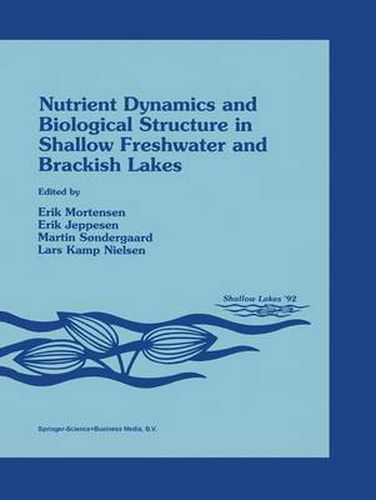Readings Newsletter
Become a Readings Member to make your shopping experience even easier.
Sign in or sign up for free!
You’re not far away from qualifying for FREE standard shipping within Australia
You’ve qualified for FREE standard shipping within Australia
The cart is loading…






This title is printed to order. This book may have been self-published. If so, we cannot guarantee the quality of the content. In the main most books will have gone through the editing process however some may not. We therefore suggest that you be aware of this before ordering this book. If in doubt check either the author or publisher’s details as we are unable to accept any returns unless they are faulty. Please contact us if you have any questions.
The nutrient dynamics and biological structure of shallow non-stratified lakes differ markedly from that of deep and stratified lakes: for example, the return of nutrients lost through sedimentation is faster and the potential importance of fish and submerged macrophytes as food-web regulators is greater. In addition shallow lakes are more easily influenced by fluctuations in the physical environment caused by wind disturbance, temperature change, etc. Although shallow lakes are often the most common lake type in lowland countries, less attention has been paid to them than to deep stratified lakes and few comparisons have been made between shallow freshwater and brackish lakes. The volume is divided into five main themes, each introduced by an invited speaker: Nutrient dynamics with special emphasis on sediment water interactions and changes in loading (Professor Lambertus Lyklema); Biological structure and trophic interaction (Professor Stephen T. Threlkeld); Submerged macrophytes: dynamics and role in the lake ecosystems (Ass. Professor Kaj Sand Jensen); Comparison of freshwater and brackish lake ecosystems (Professor Brian Moss); Modelling the impact of nutrients, the biological structure and the recovery process (Dr Marten Scheffer).
$9.00 standard shipping within Australia
FREE standard shipping within Australia for orders over $100.00
Express & International shipping calculated at checkout
This title is printed to order. This book may have been self-published. If so, we cannot guarantee the quality of the content. In the main most books will have gone through the editing process however some may not. We therefore suggest that you be aware of this before ordering this book. If in doubt check either the author or publisher’s details as we are unable to accept any returns unless they are faulty. Please contact us if you have any questions.
The nutrient dynamics and biological structure of shallow non-stratified lakes differ markedly from that of deep and stratified lakes: for example, the return of nutrients lost through sedimentation is faster and the potential importance of fish and submerged macrophytes as food-web regulators is greater. In addition shallow lakes are more easily influenced by fluctuations in the physical environment caused by wind disturbance, temperature change, etc. Although shallow lakes are often the most common lake type in lowland countries, less attention has been paid to them than to deep stratified lakes and few comparisons have been made between shallow freshwater and brackish lakes. The volume is divided into five main themes, each introduced by an invited speaker: Nutrient dynamics with special emphasis on sediment water interactions and changes in loading (Professor Lambertus Lyklema); Biological structure and trophic interaction (Professor Stephen T. Threlkeld); Submerged macrophytes: dynamics and role in the lake ecosystems (Ass. Professor Kaj Sand Jensen); Comparison of freshwater and brackish lake ecosystems (Professor Brian Moss); Modelling the impact of nutrients, the biological structure and the recovery process (Dr Marten Scheffer).